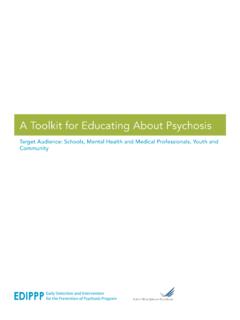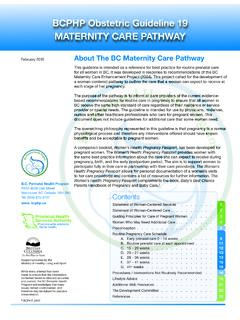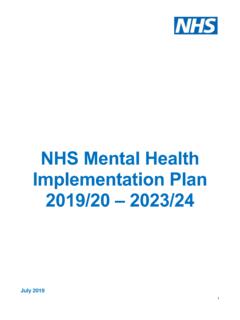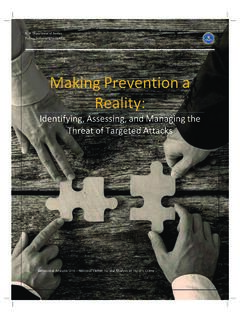Transcription of Autism Spectrum Disorder Assessment: Considerations for ...
1 Children & Adults with Autism Spectrum Page 1 of 8 Autism Spectrum Disorder Assessment: Considerations for Age and Functional Skill Level October 2018 Step One: Establishing the Autism Spectrum Disorder Diagnosis General Autism Spectrum Disorder Evaluation Points to Remember Assessment of Autism Spectrum Disorder (ASD) should be based on multiple data points (direct observation, caregiver interview, test data). The Autism Diagnosis Observation Schedule, Second Edition (ADOS-2) is a very helpful tool in ASD assessment; however, diagnosis of any condition should never be based on one test. The Autism Diagnostic Interview-Revised (ADI-R) is a standardized tool to assess for caregiver report of current and past ASD symptoms; again, this is a very helpful tool in ASD assessment. However, the ADI-R does not provide coverage for a full clinical interview, which is a necessary component of any ASD evaluation.
2 Ultimately, it the clinician s expertise with the integration of test, interview, and observational data that yields an accurate diagnosis of ASD. It is important that the examiner has a strong understanding of the child s developmental/intellectual and language status to both select the correct module of the ADOS-2, as well as to take into account developmental/intellectual functioning when making the clinical diagnosis (ASD or not ASD). The ADOS-2 module selection is based on the expressive language level of the child; scoring of the items is based on consideration of the child s nonverbal mental age. Utilizing a module lower than the child s expressive language level may result in higher rates of false negatives (saying not ASD when the child has ASD) and using a module with higher expressive language demands than what the child exhibits may result in higher rates of false positives (saying ASD when the child does not have ASD).
3 Therefore, it is essential that a clinician has accurate information about the child s developmental/intellectual profile prior to administering and scoring the ADOS-2. Administering developmental/intellectual and social observational tests to children with ASD can be challenging. Examiners must: Have a minimum of one year of experience working with and assessing children with ASD Understand psychometric data Be very knowledgeable and comfortable with the appropriate test administration procedures and rules for all tests administered Children & Adults with Autism Spectrum Page 2 of 8 Know how to utilize positive reinforcement and differential attending to motivate/shape best testing behaviors during developmental/intellectual assessment Most importantly, be able to create a fun, safe, and interesting social environment for the child to show his/her best skills It is the expectation that the examiner set the battery that is needed to address the question of ASD, as well as to provide some meaningful information for the family irrespective of the individual s ASD status.
4 Compare this to going to the pediatrician with a concern that the child has strep throat and the doctor telling the parent that it is not strep throat and sending the family on their way without feedback or recommendations to manage the child s current symptoms. It can be difficult for parents/caregivers to learn that their individual has been diagnosed with ASD. Similarly, for a parent/caregiver that has been searching for answers, it can be equally difficult to learn that the individual is NOT diagnosed with ASD; in this circumstance, it is often helpful to have some information to share with the caregiver about the individual s functioning and some guidance for next steps. Evaluations should be helpful to both the family and clinical treatment team. Aside from diagnosis, evaluations should result in meaningful recommendations for the individual s caregivers.
5 Very Young Children (age 3 and younger) Developmental functioning is an essential component of ASD evaluation at this age as the symptoms are based on what the child is developmentally capable of exhibiting. Therefore, conducting some manner of developmental and/or adaptive assessment is necessary unless such assessment has already been recently completed and the results are available. Adaptive/developmental assessment should be completed prior to the ADOS-2. The following battery is recommended: Clinical interview, including thorough assessment of developmental symptom history (medical, behavioral, and social history [ADI-R or clinical equivalent]) Developmental evaluation (Mullen Scales of early Learning, Bayley Scales of Infant Development- Third Edition) *unless testing has already been conducted to give an estimate of the child s developmental skill levels, including expressive language, receptive language, and nonverbal skills Adaptive skills (Vineland-II) Observational assessment of social behaviors (ADOS-2)
6 O Toddler module children through 30 months who are not yet flexible phrase speakers Children & Adults with Autism Spectrum Page 3 of 8 o Module 1 for children 31 months and older speaking primarily single words o Module 2 for children of ANY age who are primarily fluent, flexible phrase speakers Other Considerations for this Population Completing standardized testing with very young children can be difficult. Developmental measures (unlike most intellectual assessment measures) allow for multiple repetition of directions and items unless specifically noted in the manual. Young kids are inconsistent with displaying skills, so patience is necessary. If the child shows significant separation anxiety, which is normative at 12-24 months, the child may perform best with the caregiver in the room. The ADOS-2 does a good job of differentiating children with Intellectual or Developmental Disability (I/DD) from kids with ASD; however, this relies on the examiner s ability to correctly interpret items within the appropriate developmental context, including verbal and nonverbal skills.
7 For young children with mild to moderate global delay or intellectual disability, research has supported that the lack of use of joint attention behaviors and a flat or declining social and communication trajectory are more often seen in children ASD as compared to kids with I/DD without ASD. Remember that children with intellectual and developmental disabilities have high rates of sensory and repetitive behaviors, so these behaviors in the absence of social affective deficits should not be used to diagnose ASD, though the frequency of motoric symptoms may be higher in kids with ASD. The ADOS-2 is not a good differentiator for children with severe to profound intellectual disability. Children in this age range have a good opportunity for a positive response to intervention. Therefore, while treatment of current symptoms is necessary, on-going assessment of symptoms and developmental status is important as the current deficits should not be viewed as the child s long-term status or used for long-term planning.
8 Children & Adults with Autism Spectrum Page 4 of 8 Young Children (~ ages 4 to 6) The following battery is recommended: Clinical interview, including thorough assessment of developmental symptom history (medical, behavioral, and social history [ADI-R or clinical equivalent]) Intellectual/Developmental evaluation (Mullen Scales of early Learning [Note: Mullen norms only go through age 5:5], Wechsler Preschool and Primary Scale of Intelligence, Fourth Edition [WPPSI-IV], Differential Ability Scales, Second Edition [DAS-II] early Years Battery) *unless testing has already been conducted to give an estimate of the child s verbal and nonverbal intellectual status Adaptive skills (Vineland-II) Observational assessment of social behaviors (ADOS-2) Other Considerations for this Population The Mullen Scales of early Learning and Differential Ability Scales, Second Edition (DAS-II) early Years Battery effectively delineate receptive and expressive language skills, as well as provide a solid nonverbal intellectual score.
9 Aside from the one-word receptive language subtest, the Wechsler Preschool and Primary Scale of Intelligence, Fourth Edition (WPPSI-IV) requires verbal responses for an estimate of verbal reasoning skills. Therefore, a Mullen (if not over age 5:5) or DAS-II may be the best choice for assessment of children with known limited language output. It can be difficult to select the most appropriate ADOS-2 module for this age range. The following points should be considered when selecting the ADOS-2 module: Remember phrase speech must be spontaneous and not only echolalic (immediate or delayed) for the child to be best assessed using module 2. Some children in this age range are best assessed using module 3 for fluent sentence speakers; sentences should be complex and communicatively meaningful for the child to receive this ADOS-2 module. Many children begin speaking in basic sentences ( I want a cookie.)
10 With every now and then uttering a complex sentence ( I went to the store with my mommy. ) before they are truly verbally fluent speakers. Further, some children with ASD may be capable of speaking at a level higher than what they typically utilize; however, the selection of the module should be based on the typical expressive output of the child, rather than on the best circumstance; developmental/intellectual assessment often helps to guide this decision. For example, if the child is able to say phrases, but does not do so routinely and instead communicates in single words most of the time, the child would be administered module 1. Children & Adults with Autism Spectrum Page 5 of 8 As clearly noted in the ADOS-2 manual, if it is unclear what module the child should receive, go with the module with lower language expectations. School Aged Children/Teens/Young Adults of Suspected Intact Intellectual Skills The following battery is recommended.
















